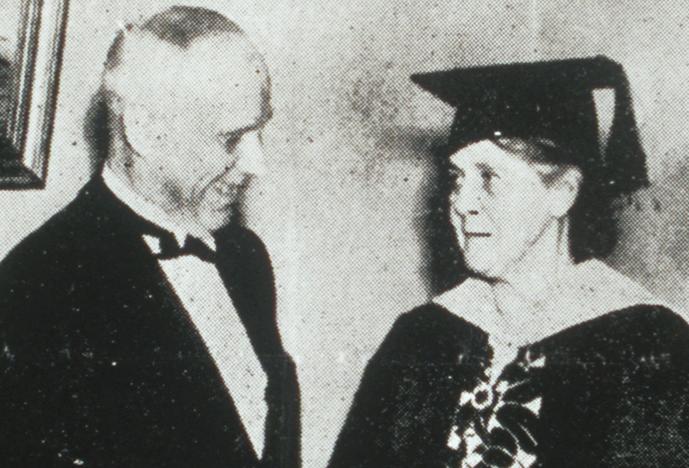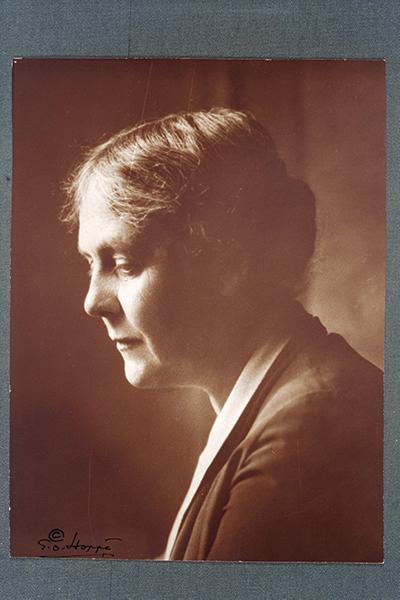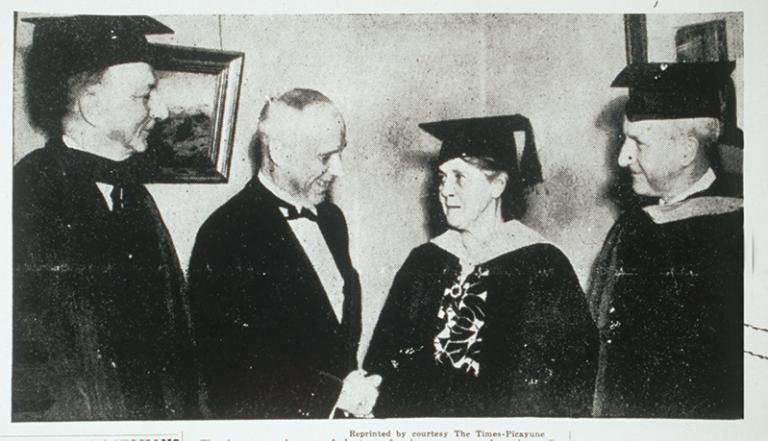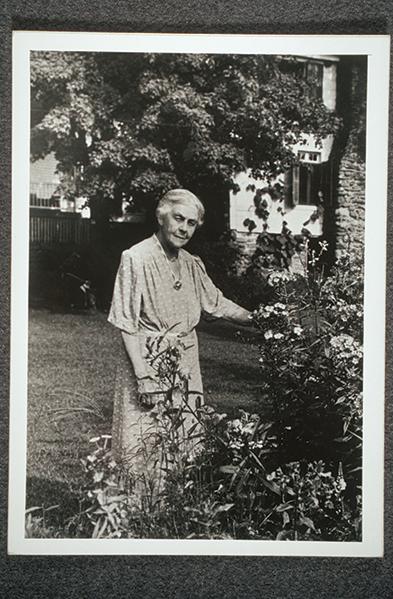The Sound of Glass Shattering
A century ago, Alice Hamilton became the first woman to be appointed to Harvard’s faculty
- 11 minute read
- Profile

It could be argued that it took a world war to get a woman appointed to the faculty of Harvard University.
As World War I was ending, HMS had begun to assess the war’s effects on the goals of the School. A certain number of graduates, it found, had the talent and training to provide public service in many ways beyond solely providing clinical care. To translate this knowledge into action, the School’s leaders decided they should add to its primary focus on educating clinical practitioners.

In his 1918-19 report to A. Lawrence Lowell, the president of Harvard, HMS Dean David Edsall noted, “federal and local government and bodies related thereto, commercial and social organizations and others have many problems of health that are of humane or economic importance.” Edsall had further evidence for the depth of support for such an initiative; he had accumulated $325,000 from industrial corporations to fund research and teaching concerning these health problems. As a result, Edsall sought to expand the HMS curriculum to include preparing students for careers in public health and industrial health.
To realize this new direction, Edsall proposed appointing Alice Hamilton, whose work in industrial health had pioneered the field in the United States. Hamilton had come to his attention during their work as members of a National Research Council committee on munitions workers.
He had another reason for suggesting Hamilton, however. Edsall was aware that Harvard was beginning to stand out for its failure to enroll women as students or appoint them as faculty. He addressed the issue in a letter to President Lowell, “I should be very glad to know that there would be no objections to appointing her because of her sex. … I would emphasize the fact that she is greatly superior to any man that we can learn of for such a position.”
In December 1918, Edsall offered Hamilton an appointment as assistant professor of industrial medicine to participate in teaching medical students a new curriculum in that field and continue her research in industrial health. By March of the following year, her appointment was confirmed in a meeting of the President and Fellows of Harvard College.
Reflecting on her appointment in her autobiography, Hamilton wrote, “I was told that the Corporation was far from enthusiastic …and that one member had sworn roundly over it. But then said my informant, ‘you know he always swears.’ ”
Groundswell
Hamilton’s path to the appointment at Harvard had been long and winding, yet she had persisted because she recognized that it would validate her work and the role of women in science and academia.
She was right. Her appointment generated a flood of news stories across the country. Clippings archived at Harvard’s Pusey Library come from newspapers in California, Illinois, Massachusetts, Montana, New York, Ohio, and Wisconsin.
Asked by a woman reporter from the Boston Herald whether women should be admitted to the Harvard Medical College, she responded, “Of course I believe in admitting women to Harvard. Isn’t it the last stronghold that is now against them? All the other first-class medical colleges admit women. And if women want to make medicine their profession, surely, they should have the best schools open to them for their study. I’m afraid I’m too western, with too many coeducational experiences, to grasp a situation where the line is drawn between men and women students … I am not used to considering questions of women’s education apart from those of men’s.”
When Hamilton accepted the appointment at Harvard, she did so with the proviso that the appointment should be half-time, leaving her free to continue her field work studying the dangerous trades. Harvard, too, set stipulations: She must not enter the Faculty Club, march in the commencement procession, or receive football tickets, a perk highly prized by the male faculty. Her ticket to the commencement platform sternly warned “under no circumstances may a woman sit on the platform.
Thirst for learning
Born in 1869, Hamilton was brought up in Fort Wayne, Indiana, in a family of four girls and one boy that, with a platoon of cousins, was its own little society. Sustained with some difficulty by money inherited from a pioneering grandfather, the family offered the children schooling at home. The curriculum emphasized languages, literature, and history, supplemented in late adolescence by two years at Miss Porter’s School in Connecticut. Arithmetic and science were not offered either at home or at Miss Porter’s.
Her personal development was marked by competing urges—intellectual satisfaction versus service to others. Should she be an academic researcher or a missionary? The choice of medicine offered a way to do both. Her medical training was haphazard at first.

After private tutoring in mathematics and science she spent two years in what she regarded as a third-rate medical school in Indiana before being admitted as a special student in the medical department of the University of Michigan. Michigan offered a medical curriculum that emphasized science, early exposure to clinical work, and an intellectual atmosphere that Hamilton relished. It also was receptive to women students; nearly 30 percent of the students in her class were women.
She graduated from Michigan in 1893 and accepted internships at Northwestern Hospital for Women and Children in Minneapolis and later at New England Hospital for Women and Children in Boston. Although determined to be a career scientist, she wanted clinical experience to broaden her approach. Unfortunately, inadequate supervision and general disorganization at both institutions led her to leave before completing her program. By 1895 she was again at Michigan, this time for a one-year appointment as a resident graduate and lab assistant to Frederick G. Novy, a distinguished bacteriologist.
Following a year in Germany with her sister Edith, who later became a noted author on classical Greece and Rome, Hamilton went to Johns Hopkins University Medical School, where she worked on anatomical pathology with Simon Flexner, then a young pathologist. She also became acquainted with that school’s five founders, including surgeon William Halsted, gynecologist Howard Kelly, clinician William Osler, and bacteriologist William Welch, each a giant in medical research and education. She delighted in the intellectual stimulation and discipline, as well as the brilliance of the men she worked with, who accepted her “without amusement or contempt or even wonder.”
When the year was over, she accepted a position to teach pathology at the Women’s Medical School of Northwestern University in Chicago. A dividend of that position was the opportunity to live at Hull House, already the most famous settlement house in the United States.
Originally, Hull House had been a mansion on Chicago’s West Side, but by 1893 it was a relic in a chaotic slum peopled by desperately poor individuals, both immigrant and native-born, living in dilapidated houses with open latrines. Alcoholism, crime, and poor health further crippled their lives. The settlement house movement sought to alleviate such conditions.
While she was in Indiana, Hamilton had attended a lecture by Jane Addams, the founder of Hull House. The presentation sparked Hamilton’s imagination, and she became excited by the adventure of knowing Addams and participating in settlement life. Here lay Hamilton’s opportunity to realize her long-held wish to be of service.
The relationship became a mainstay for Hamilton. For nearly forty years, Hull House was a home base to which she returned regularly from participation in world affairs.
Industrial strength
Hamilton’s career in industrial health came together slowly as her Hull House experiences multiplied. Faced with the realities of dangerous working conditions among her Chicago neighbors, she was surprised to find that the United States had no provision for the prevention and treatment of, and compensation for, industrial injuries. She attributed this lack of interest to the field’s status as one “tainted with socialism or with feminine sentimentality for the poor.”

Hamilton educated herself in the literature from countries where industrial health was an established branch of medicine, and studied a Chicago typhoid epidemic. That preparation proved useful; she was one of the initial appointees to the Illinois Occupational Disease Commission, the first of its kind in the nation. During her tenure on the commission and afterward, she was the pivotal researcher for a study published in 1911 that investigated the occupational hazards of lead, arsenic, brass, carbon monoxide, the cyanides, and turpentine. As the study’s managing director, she assigned herself lead poisoning. Employing what she termed “shoe leather epidemiology,” she became an expert on the intricate industrial processes that involved lead.
Her industrial-health career accelerated when she took leave from the Illinois work to attend an international conference on occupational accidents and diseases in Brussels. Her participation there resulted in an invitation from another attendee, Charles O’Neill, then commissioner of labor in the U.S. Department of Commerce, to conduct a national study of lead in industry. She left academic research and devoted herself enthusiastically to a new life “that was scientific only in part, but human and practical in greater measure.”
Her success was entirely the result of her personal charm and relentless focus. Working in the era of the great muckrakers—who used confrontation to promote change by shaming and guilt—she took a different tack.
Hamilton’s approach assumed that the factory owners, managers, and foremen wanted to improve the health and safety of workers but needed factual evidence of problems. She supplemented direct factory visits with combing hospital records to calculate the toll of sickness and injury.
This approach was grounded in lessons from Hull House. There, Hamilton had learned the power of first establishing a friendly relationship with those in charge and then drawing upon those peaceful relations as one steadily pushed toward one’s goal.
This astute technique proved successful in her investigations of a range of dangerous working conditions: phosphorus poisoning in match manufacturing, silicon dust as a respiratory hazard in enameling, carbon monoxide exposure in the steel production industry, and the physical toll of working twelve-hour days seven days a week.
It was her careful documentation of this work and publication of her findings that prompted Edsall to support her for the HMS appointment.
The 1920 HMS catalog listed Hamilton’s industrial toxicology lectures as occurring twice a week during the fall term. Two years later, in a report to President Lowell, Edsall proposed the need for a separate school of public health. He felt such a development would “prove to be the most important one for many years in its influence upon the future prominence and activity of the Medical School.”
With the establishment of the separate school, Hamilton began teaching the toxicology course as a member of the public health school’s faculty. While there, she published two books, Industrial Poisons in the United States, in 1925, and Industrial Toxicology, in 1934.
Inconvenient truths
Hamilton’s commitment to humanitarian service also continued. Following World War I, she participated in the Quaker efforts to relieve starvation in Germany and served on the health committee of the League of Nations. She was a vocal advocate for birth control.
She traveled in both Germany and Russia as their governments evolved. In Germany, she was appalled by the Nazi persecution of Jews and the growing threat of fascism. Soon her commitment to pacifism melted into strong support for World War II. In the 1950s, her political interests and associations multiplied as the tide of McCarthyism threatened civil liberties and freedom of speech in the United States. She joined a host of prominent intellectuals and other public figures caught up in the anticommunist furor of that time, associations that some speculate resulted in an FBI file.
In her retirement years, she began consulting for the U.S. Department of Labor, Division of Labor Standards, and, with Harriet Hardy, an occupational medicine specialist and the first woman full professor in a clinical department at HMS, revised her seminal text, Industrial Toxicology. She also received multiple awards, including the prestigious Lasker Award, presented for her contributions to workers’ health. She was the first woman to receive a Lasker.
In full retirement, she moved with one of her sisters to a colonial farmhouse in rural Connecticut to garden and keep up a vigorous correspondence with her old friends and contemporary political figures, such as jurist Felix Frankfurter. She died on September 22, 1970, at the age of 101.
Throughout her career, Hamilton fought with graceful determination what she described as the feudal organization of industry, in which the owners of companies, as “lords,” wielded immense power over the “serfs,” the immigrants and unskilled laborers who worked for them. Her work to protect the health and safety of ordinary workers remains as important today as it was a century ago when this visionary researcher and citizen of the world became the first woman to be appointed to the faculty of Harvard University.
Eleanor G. Shore, MD ’55, MPH ’70, retired as the HMS Dean for Faculty Affairs in 2004; Miles F. Shore, MD ’54, is the HMS Bullard Professor of Psychiatry, Emeritus.
Images: E.O. Hoppé estate collection/Schlesinger Library, Radcliffe Institute, Harvard University (Hamilton portrait, top); Schlesinger Library, Radcliffe Institute, Harvard University (Hamilton in garden and receiving award)